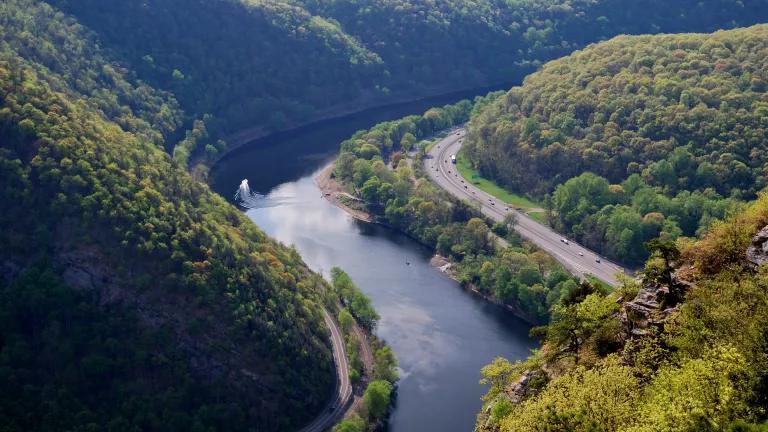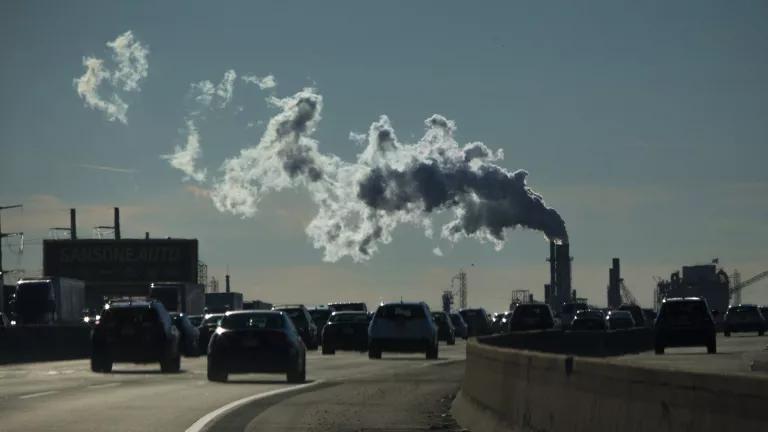
NRDC was very pleased to host the Standing Rock Sioux Tribe on their recent trip to Washington DC. The Tribe and NRDC met with various Congressional staff about their continued frustrations with the US Army Corps of Engineers (the Corps) and Energy Transfer over the Dakota Access Pipeline (DAPL). The Tribe’s concerns are many, and are very serious, but come down to three areas of concern: Energy Transfer’s operations are unsafe, unaccountable and unlawful.
Rerouted across stolen land
The Dakota Access Pipeline, owned and controlled by Energy Transfer, was initially planned along a shorter more direct route that would have crossed the Missouri River near Bismarck, north of the Standing Rock Reservation (New Yorker). Bismarck residents successfully blocked the pipeline, due to concern that a leak or spill would contaminate their drinking water supply. Without input from the Standing Rock Sioux and other area Tribes, the pipeline was rerouted south, just a half a mile from the reservation, across land that was seized without consent from the Tribe in 1958 (see 1851 Fort Laramie Treaty Sioux lands). The pipeline traverses Tribal sacred areas, burial grounds, and hunting and fishing areas—all expressly protected by treaties and reaffirmed by Congress and the courts.
Now, the oil and gas pipeline runs underneath Lake Oahe that borders the Reservation and is the sole source of the Tribe’s drinking water, giving rise to what has become the iconic slogan of the NoDAPL movement—Mni Wiconi, Water is Life—and the name of Water Protectors to the Standing Rock Tribe.
See map by Carl Sack as presented in the Independent, Nov 30, 2016.

Energy Transfer unsafe
Pipeline hazards are a problem across the industry, with over 1,700 reportable pipeline incidents including 775 significant incidents since the 2016 Pipes Act passed. But likely the worst pipeline safety violator is Energy Transfer and its subsidiary entities such as Sunoco, Rover Pipeline, and Dakota Access Pipeline (DAPL).
For example, government data from the federal Pipeline and Hazardous Materials Safety Administration (PHMSA) shows that over the last 13 years there have been over 450 spills from Energy Transfer pipelines, resulting in over $100 million in property damage from over 2.5 million gallons of hazardous liquid spilled. Energy Transfer experienced 45% more hazardous liquid spills than any other the pipeline company in this period, averaging 3 spills a month.
Just in 2017-2018, Energy Transfer corporate-wide hazardous liquid spills have resulted in over $20 million in property damage, indicating a pattern of increased harm from the company’s most recent hazardous liquid pipeline operations.
Late last year it was reported that Energy Transfer Partners and Sunoco had amassed more than 800 state and federal permit violations while building two pipelines across Pennsylvania and Ohio. Meanwhile, during construction of its natural gas Rover Pipeline, Energy Transfer subsidiaries spilled over 150,000 gallons of drilling fluid into an Ohio wetland. (Rover Pipeline is also under investigation for destroying a historic building without obtaining the proper consent and hiding it from FERC).
Energy Transfer has failed to meet even its own industry voluntary recommended practices addressing pipeline safety systems, leak detection and integrity management systems that have been developed by the American Petroleum Institute (API; for example, see API RP 1173 on safety management, AP RP 1175 on leak detection, and AP RP 1160 on system integrity for hazardous liquids). Failure to follow even these basic industry recommendations demonstrates a top-down callous disregard for the health and safety of its own employees and those whose land and livelihood its pipes traverse.
DAPL unsafe
The Dakota Access Pipeline has been operating for nearly two years now, but it fails to incorporate even the voluntary API industry recommended pipeline safety practices, despite false promises in the project’s Environmental Assessment to meet or exceed such safety practices. It has already experienced 12 spills of over 6,100 gallons of highly toxic Bakken crude oil.
Shut-off valves along the Dakota Access Pipeline meant to protect Lake Oahe and the Missouri River from a serious crude oil spill lack back-up power and are not “fail safe”—although a stated requirement of the Army Corps of Engineers easement conditions. The Corps’ assessment of risk dwells in the murky world of generic incident data, a limited list of general threats, crude oil analysis that lacks the specifics toxic hazards of Bakken crude and best-case projections. Missing is the real risk data of actual ETP/Sunoco performance and any verification that the company’s systems are performing as advertised.
Emergency responders and communities across the US are left vulnerable due to the lack of transparency with pipeline operators’ Facility Response Plans. From its Mariner East 2 pipeline in Pennsylvania to Dakota Access Pipeline, Energy Transfer has redacted whole sections of vital information including key data such as worst-case discharge which responders need to have sufficient staffing and equipment for effective response to emergencies.

Legal victory
In response to the December 2015 Corps’ Environmental Assessment that evaluated potential impacts of passing under Lake Oahe, several Tribes raised a long list of concerns including a lack of analysis of potential impacts on water resources and other treaty resources. Those concerns were echoed in public comments by the Department of Interior, the Environmental Protection Agency, and the Advisory Council on Historic Preservation. Despite these concerns by the Standing Rock Sioux and other area Tribes, and federal agencies, in July 2016 the Corps published its final Environmental Assessment concluding that there would be no significant impacts. The Tribe responded in a series of lawsuits that are ongoing. (See Earthjustice website for updates).
In a legal victory for the Tribe, a June 14, 2017 ruling suspending the project, a district court held that the federal government failed to consider the impact of a spill on the Tribes’ hunting and fishing rights, among other issues, in its environmental impact assessment:
- “The problem here, as the Tribe points out, is that this analysis covers only construction impacts, not spill impacts…. This limited analysis, the Court believes, is not enough to discharge the Corps’ environmental-justice responsibilities under NEPA" (see DAPL Order p. 53)
- "the agency failed to adequately consider the impacts of an oil spill on Standing Rock’s fishing and hunting rights and on environmental justice, and in February 2017, it did not sufficiently weigh the degree to which the project’s effects are likely to be highly controversial in light of critiques of its scientific methods and data." (see DAPL Order p. 66)
The pipeline—opposed by the Tribe since the beginning—now has capacity to move about 600 thousand barrels per day of oil over 1,000 miles from the Bakken shale formation in North Dakota to refineries in southern Illinois.
With the pipeline operator such a rogue company, and now trying to increase capacity even though there has been no transparency, the Tribal community is facing tremendous health and safety risks, living under constant stress, and facing continued government failures.
Government and Industry unaccountable
PHMSA data shows that since 2010 for Energy Transfer pipelines supervisory control and data acquisition (SCADA) and computational pipeline monitoring (CPM) systems detected pipeline right-of-way spills only 12% of the time—random observations by the public were nearly 4x more effective in detecting leaks. PHMSA studies have shown that industry leak detection is unreliable, but the agency continues to fail to require modern leak detection standards across the industry, and Energy Transfer continues to fail to meet industry recommended safety practices.
Other Federal Agencies for example EPA and OSHA have implemented a safety system approach to preventing major accidents since the 1990s. The Department of Interior implemented safety system regulations in response to the Macondo incident. PHMSA’s failure to develop safety management system regulations leaves communities in harm’s way.
It has been eight years since Congress directed PHMSA to undergo necessary rulemakings on key mandates and recommendations such as hazardous liquid safety and emergency shutoff valve requirements. It has still not done so.
Recommendations
- The authorizations for the Pipeline Safety Act and the Pipeline and Hazardous Materials Safety Administration (PHMSA) expire on September 30, 2019, so Congress will need to take up reauthorization legislation this spring and summer. As it does this, it should include requirements for targeted risk reduction, verification of effective safeguards and performance, the incorporation by reference of more rigorous safety standards, much stiffer penalties for safety violations and facilitated agency rulemaking capabilities.
- PHMSA can use its emergency order authority to predict and prevent imminent, industry-wide safety failures that pose a threat to life or harm to property or the environment.
- The Transportation Security Administration (TSA) must address the recommendations of the recent US Government Accountability Office report (GAO-19-542T, May, 2019), which identified numerous significant weaknesses in TSA’s failure to manage pipeline security. Problems in need of corrections include: outdated risk assessment methods; outdated pipeline security guidelines; and, failure to track security review recommendations.
- We will see how seriously the Trump Administration takes the new reauthorization mandate from Congress. But our confidence is low given the fact that a TSA representative refused to attend the recent congressional hearing on this issue, that PHMSA has proposed to cut funding for grants available to states, and that PHMSA just recently gutted other critical safety protections for offshore drilling.
- Congress must provide oversight and pressure to see that GAO’s recommendations are followed. We are pleased that Congressman Frank Pallone Jr (D-NJ) is already taking measures to hold PHMSA and other federal agencies accountable (See his statement from a recent May 2019 hearing). Other members of the House Energy and Commerce Committee also raised some of our concerns, but more needs to be done to ensure federal agencies adhere to the National Environmental Policy Act, and that irresponsible pipeline owners and operators like Energy Transfer and Sunoco are held accountable for all the harm they’re doing.
More information:
- Written statement to Congress from Standing Rock Sioux Tribal Council Chairman Mr. Mike Faith Jr., May 1, 2019.
- Report of the Standing Rock Sioux Tribe: Impacts of an Oil Spill from the Dakota Access Pipeline on the Standing Rock Sioux Tribe, February 21, 2018 (SRST NoDAPL Remand Report Final)
- Statement of failures from Chairman Mike Faith Jr, Standing Rock Sioux Tribal Council, March 11, 2019
- See the Earthjustice website for all legal documents, summaries, and updates related to DAPL litigation





